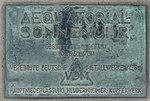Equatorial sundial (Frankfurt am Main)
The Frankfurt equatorial sundial , sometimes also referred to as a copper clock , is an additional ring-shaped equatorial sundial designed as a world time clock . It has been standing in Frankfurt 's city center since 2004 on a green area west of the Ignatz-Bubis Bridge on the banks of the Main below the Schöne Aussicht . When it was inaugurated in 1951, the Frankfurt equatorial sundial was the largest sundial of its kind in the world.
Functions as an ordinary sundial and as a world time sundial
The scale for displaying the time of day is located on the equator of the sundial designed as an armillary sphere . A pole mounted between the celestial poles serves as a shadow projector . The wide range of scales contains a separate scale for each of the twelve months, which takes account of the time adjustment and shows Central European time . Roman numerals are attached to the top of the wide scale to indicate the true local time .
A narrow ring parallel to the main scale band is the world time ring with the names of 200 cities around the globe on it. It can be rotated around the celestial axis or the pole rod. If it is turned from the position for Frankfurt to east or west to a position for another city, the Frankfurt time is no longer displayed on its inner surface, but the time prevailing in the selected city. This setting can be made both for the display of their true local time and their zone time . To display the zone time, you must pay attention to the current month when setting (see third of the adjacent photos). If the true local time is desired, it is set to September 1st. That is one out of four days in the year on which the time compensation is zero. If the ring remains in its Frankfurt position, it is noon at the longitude on which the shadow of the pole rod falls. The latter application is the usual one for simple world time clocks in which the ring cannot be rotated.

Dates and history
The clock, largely made of copper , weighs around 1000 kilograms with a diameter of 3.6 meters. The bracket of the watch is made of galvanically copper-plated steel, as a copper construction would have been too weak for the weight of the watch. Frankfurt was not originally marked on the Weltzeitring; it was subsequently attached to a sign on the Weltzeitring.
The Frankfurt equatorial sundial goes back to an idea by the engineer and watchmaker Lothar M. Loske (1920–1992), who designed it in the late 1940s. The clock was built with a construction time of two years by the United German Metal Works (Heddernheimer Metallwerke) . A total of 6000 working hours were required for construction, transport and installation; the construction costs amounted to 21,000 DM . The engineer Hildegard Langeloth was entrusted with the construction; she received support with astronomical expertise from her husband Kurt Langeloth. The sundial was set up on Untermainkai in the Nice park ( ⊙ ) and inaugurated on April 26, 1951. The Heddernheimer Metallwerke presented the watch to the city of Frankfurt as a gift.
As the trees on the Nice had become so tall that they shaded the clock, and space was needed to build a new restaurant, the sundial was moved 1.4 kilometers east to its current location in 2004 after restoration. She received a new stone base. The step attached to the original base, which should enable smaller people to operate the world time ring more easily, has been omitted. The deed of gift, which was housed in a role in the former step, has since been kept in the Institute for Urban History of the City of Frankfurt.
Picture gallery
Main scale: morning start; VI = true local time; Scale strips for CET
literature
- Lothar M. Loske: The sundials. Time measurement works of art and their secrets Berlin, Göttingen 1959: Springer. Pp. 75-81.
- Reinhold R. Kriegler: From Nice to Beautiful Views. The Frankfurt equatorial sundial by Lothar M. Loske. In: Deutsche Gesellschaft für Chronometrie , annual publication 2005. pp. 185–190. ( Online as PDF )
Web links
- Art in Public Space Frankfurt: Equatorial Sundial (Frankfurt am Main)
- At equatorial sundial in Frankfurt a. M. by Reinhold Kriegler (English, with many historical images)
Coordinates: 50 ° 6 '32.2 " N , 8 ° 41' 28.1" E



















